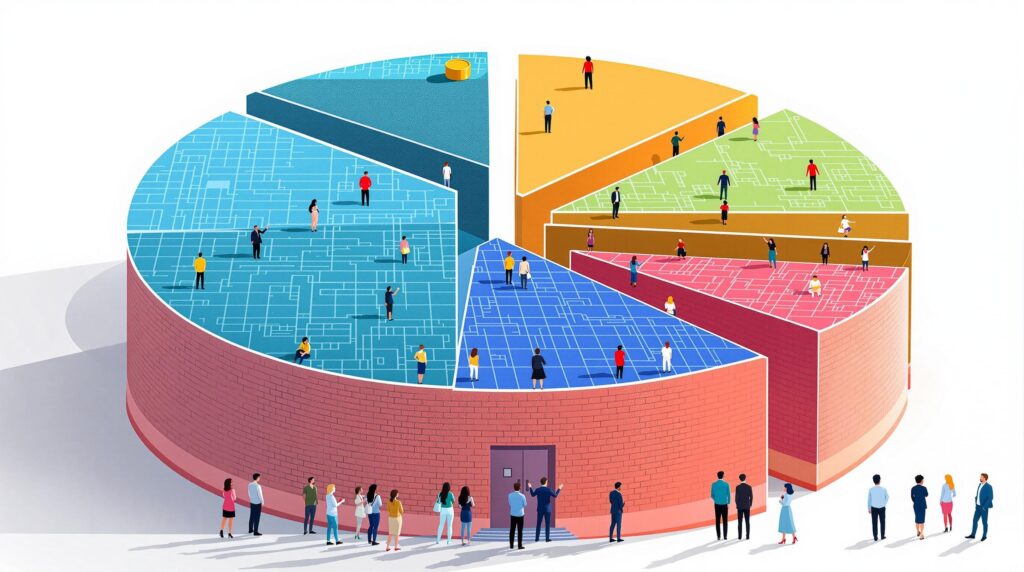[rev_slider alias=”slider-1″][/rev_slider]
Understanding Layer 1 Blockchains: The Backbone of Decentralization
The world of blockchain is evolving rapidly, and at the forefront of this digital revolution are Layer 1 blockchains. But what exactly are Layer 1 blockchains, and why are they so pivotal in shaping the future of decentralization? Let’s dive deeper into their significance and their role in transforming the global financial landscape.
What is a Layer 1 Blockchain? A Layer 1 Blockchain is the underlying base layer of the blockchain architecture. It includes the primary network, such as Bitcoin or Ethereum, that provides the foundational structure for operations and transactions.
The concept of Layer 1 blockchains may sound technical, but think of it like the backbone of the internet for the blockchain realm. They function as the primary ledger systems—similar to highways connecting various digital neighborhoods. Without robust Layer 1 networks, other applications and protocols would lack a solid foundation to operate on.
The Role of Bitcoin and Ethereum as Leading Layer 1 Blockchains
Bitcoin and Ethereum are often hailed as the trailblazers in the blockchain ecosystem, and rightly so. These platforms serve as a testament to the capability of Layer 1 blockchains. Bitcoin, often referred to as digital gold, was the first successful cryptocurrency utilizing a decentralized ledger technology. Its primary focus is on securely transferring digital value across parties without the need for intermediaries.
- Bitcoin: Introduced in 2009, Bitcoin stands as the pioneer, having ignited the cryptocurrency revolution. It’s renowned for its decentralized nature and proof-of-work consensus mechanism, which ensures security and immutability.
- Ethereum: Launched in 2015, Ethereum expanded the capabilities of blockchain technology. Unlike Bitcoin, it allows for smart contracts—self-executing contracts with the terms of the agreement directly written into code. This innovation paved the way for decentralized applications (dApps) transforming various sectors such as finance and medicine.
Challenges Faced by Layer 1 Blockchains
Despite their groundbreaking nature, Layer 1 blockchains face significant challenges. Scalability, for instance, remains a prominent hurdle. As the user base and transaction volumes increase, congestion becomes inevitable, leading to higher transaction fees and slower processing times. This has been particularly apparent with Ethereum during periods of high transaction demand.
Moreover, the energy consumption associated with proof-of-work systems like Bitcoin has drawn criticisms. These systems require a significant amount of electricity for mining operations, which has given rise to environmental concerns. In response, Ethereum is transitioning to a proof-of-stake system aimed at reducing energy usage significantly.
Addressing Scalability Issues: Scalability in blockchain refers to the system’s capacity to handle a growing amount of work, and its capability to expand and support more transactions per second.
The African Landscape: A Fertile Ground for Blockchain Innovation
Africa, with its unique economic context and burgeoning digital ecosystem, offers immense potential for blockchain adoption. The continent is a perfect testing ground for innovative blockchain solutions, like those offered by Jara, that aim to bridge global capital with African assets.
Jara stands at the forefront of this transformation, leveraging the power of blockchain to address financial inclusion and economic empowerment. By tapping into Africa’s infrastructure gap, Jara seeks to harness the digital asset market poised to surpass $200 billion. The company’s initiatives, such as the $6 billion Lagos airport tokenization project, represent a vibrant opportunity for token investors.
Linking Innovations with Practical Applications
Jara’s ecosystem illustrates the practical applications of blockchain technology. It combines a decentralized multi-chain wallet, a proprietary Layer 2 blockchain, and a tokenization engine to facilitate seamless financial transactions and investments. This creates an inclusive financial environment, particularly for regions like Africa where traditional banking systems are less accessible.
Furthermore, the integration of AI-powered influencers and community-driven approaches ensures broad user engagement. As more African enterprises and individuals embrace blockchain, innovations from companies like Jara could lead the charge toward a digitally inclusive future.
- Seamless Transactions: Utilizing Jara’s decentralized wallet and Layer 2 blockchain ensures low transaction costs and fast processing, ideal for everyday financial activities.
- Digital Asset Tokenization: By tokenizing real-world assets like infrastructure projects, Jara provides a unique investment opportunity unlocking previously untapped markets.
In conclusion, Layer 1 blockchains form the essential infrastructure underpinning the world of decentralized technology. While challenges remain, the strides made by platforms like Bitcoin and Ethereum continue to pave the way for a future where financial accessibility and innovation thrive. With Africa at the cusp of this transformation, platforms like Jara are not just participants, but pioneers leading this charge.
The Fundamentals of Personal Injury Law
At our law firm, we understand the intricacies of personal injury law and are committed to ensuring you receive the justice you deserve. But what exactly is personal injury law? Let’s dive into the essentials to make things clearer.
What is Personal Injury Law?
Personal injury law, often referred to as tort law, allows an injured individual to file a lawsuit in a civil court against the person or entity legally responsible for their injuries. This legal framework enables victims to seek compensation for losses that arise from accidents and other incidents.
“Personal injury law is about fairness – making sure that those who cause harm pay for the damages they cause.” – Our Experienced Lawyers
Common Types of Personal Injury Cases
- Auto Accidents: Most personal injury claims in the United States arise from accidents involving cars, trucks, and motorcycles. If you have been hurt in an auto accident due to someone else’s negligence, you might be entitled to compensation.
- Slip and Fall: These incidents occur when a person slips, trips, or falls due to hazardous conditions on someone’s property.
- Medical Malpractice: This involves negligence by health care professionals leading to patient harm.
- Product Liability: Injuries caused by defective or dangerous products can give rise to a lawsuit against manufacturers or suppliers.
- Workplace Accidents: These are injuries sustained while performing job duties, often leading to workers’ compensation claims.
“Your health and safety should never be compromised at work or anywhere else.” – Law Firm Perspective
Proving Negligence in Personal Injury Cases
One of the key components in these cases is proving negligence. To succeed, as a claimant, you must establish several elements:
- Duty of Care: You need to prove that the defendant owed you a standard level of care under the circumstances.
- Breach: Show how the defendant failed to meet that duty of care.
- Causation: Demonstrate that the defendant’s breach directly caused your injuries.
- Damages: Provide evidence of the losses you’ve suffered, whether physical, emotional, or financial.
“The path to recovery begins with a solid understanding of your rights.” – Our Commitment to Educating Clients
Understanding Compensation: What Can You Recover?
In a personal injury case, your primary goal is to recover damages. These damages are intended to compensate you for losses related to the accident or injury. Here’s a breakdown of what you might claim:
Types of Damages
- Medical Expenses: Compensation for doctor visits, surgeries, medications, and any ongoing healthcare needs.
- Lost Wages: Reimbursement for earnings lost due to your inability to work while recovering.
- Pain and Suffering: These non-economic damages account for the physical pain and emotional distress caused by the injury.
- Property Damage: Cover costs of repairing or replacing damaged property.
- Loss of Consortium: Compensation for the impact of the injury on relationships with your spouse or family.
“Nothing is more valuable than your peace of mind. We fight for the fullest compensation you deserve.” – Our Dedication to Clients
Settling vs. Going to Trial
A majority of personal injury cases are settled out of court, meaning both parties agree on a compensation amount without needing a trial. However, if a fair settlement can’t be reached, taking the case to court might be necessary. It’s crucial to have experienced legal representation to weigh your options strategically.
“Whether settling or going to trial, the right strategy can make a world of difference.” – Legal Strategy Insights
The Role of an Attorney in Personal Injury Cases
Our lawyers are here to advocate for you every step of the way. Here’s how we can assist you:
How Our Attorneys Assist
- Evidence Collection: Gathering vital information to support your case, including medical records and accident reports.
- Negotiating with Insurers: Handling discussions and negotiations with insurance companies to ensure you receive fair compensation.
- Legal Representation: Representing you in court if the case goes to trial, ensuring that your voice is heard and rights are protected.
- Personal Guidance: Offering compassionate and personalized advice throughout the entire legal process.
“From the first conversation to the final verdict, we stand by your side, advocating fiercely for your rights.” – Our Promise
FAQs: Personal Injury Law Explained
Do I Have a Valid Personal Injury Claim?
Each case is unique, but generally, if you’ve been injured due to someone else’s negligence, you might have a valid claim. It’s best to consult with an attorney who can assess your specific situation.
How Long Do I Have to File a Lawsuit?
The time limit, known as the statute of limitations, varies by state and type of injury. Most states allow two to three years from the date of the injury to file a lawsuit. It’s important not to delay as evidence can become harder to collect over time.
What If I Was Partially at Fault?
States have different rules, but even if you were partially at fault, you might still recover some damages. This depends on the state’s laws regarding comparative negligence.
“Your concerns deserve immediate attention. Never hesitate to reach out for clarity and legal guidance.” – Encouragement to Seek Help
[rev_slider alias=”text-call-cta”][/rev_slider]
Understanding the Compensation Process
What happens after a personal injury claim is filed? Navigating the compensation process can seem daunting, and understandably so. Here’s a breakdown to make things clearer.
- Evaluation of the Claim: Once your claim is filed, it goes through an assessment. Insurance adjusters will evaluate the details of your case, examining medical records, witness statements, and other evidence.
- Negotiation Phase: Often, insurers offer a settlement amount. At this stage, your lawyer negotiates on your behalf to ensure you receive fair compensation that covers all damages.
- Settlement Agreement: If an agreement is reached, the insurance company will provide the agreed-upon amount, and the case is closed. However, if negotiations fail, the case may go to trial.
Common Challenges in Personal Injury Claims
Issues can arise at any point throughout the claims process. Here are some common challenges:
| Challenge | Description | Solution |
|---|---|---|
| Denied Liability | The opposing party may deny responsibility for the incident. | Your attorney can gather additional evidence and work with experts to strengthen your claim. |
| Low Settlement Offers | Insurance companies may initially offer less than what you’re entitled to. | Effective negotiation by an experienced lawyer can counteract this, aiming for a fairer offer. |
| Complex Legal Procedures | The legal process can be complicated, and procedural errors can jeopardize your case. | An experienced personal injury lawyer will navigate these complexities on your behalf. |
“It’s not just about compensation; it’s about reclaiming your life after an accident.”
Why Hiring a Personal Injury Lawyer Makes Sense
When you’re dealing with the aftermath of an accident, it’s crucial to have an expert in your corner. Why? Let’s delve in.
Expertise and Knowledge
Personal injury law can be complex, with many rules and requirements that can vary by state. Having a lawyer means you’ll have someone knowledgeable guiding you through the maze, ensuring all legal protocols are followed.
- Understanding of the Law: Lawyers are well-versed in the nuances of personal injury law and can leverage this expertise effectively on your behalf.
- Access to Resources: A seasoned lawyer has access to expert witnesses, investigators, and medical professionals who can build a robust case.
Maximizing Compensation
Your lawyer’s goal is to ensure you get the best possible outcome. They assess entire scope of damages, including:
- Medical Expenses: All current and future medical costs related to your injury.
- Lost Wages: Compensation for the income lost due to your inability to work.
- Pain and Suffering: Monetary compensation for physical pain and emotional distress.
“Your fight is our fight.” – Let our expertise be the difference in your personal injury claim.
Choosing the Right Lawyer for Your Case
Finding the right lawyer is vital for a successful claim. But how do you know who is the right fit? Here are some tips:
Check the Lawyer’s Track Record
Research their past case successes. A lawyer with a strong record in personal injury cases is more likely to win favorable outcomes.
- Experience: More years in practice generally means a deeper understanding of the nuances of the law.
- Client Reviews: Testimonials can provide insight into the lawyer’s ability to handle cases effectively and compassionately.
Clear Communication
Your lawyer should keep you informed at every stage of the process. Open communication ensures you’re never left in the dark, giving you peace of mind.
“We value open dialogue – your needs and voice matter to us at every step.”
Frequently Asked Questions
What Documents Do I Need to Start a Personal Injury Claim?
To help your lawyer build a compelling case, gather the following:
- Medical Records: Details of your injuries and treatments.
- Police Reports: Official documentation of the incident.
- Witness Statements: Accounts from those who saw the incident.
How Long Do Personal Injury Cases Take to Settle?
The timeline varies based on several factors, including the case’s complexity and whether it goes to trial. Some cases settle in a few months, while others might take years.
Can I Handle a Personal Injury Case on My Own?
While it’s possible, it’s not recommended. The legal process is intricate, and having a skilled lawyer can significantly increase the chances of a favorable settlement.
“Navigating the aftermath of an accident is challenging, but you don’t have to do it alone.”
Conclusion
Understanding personal injury claims can be overwhelming, but with the right information and legal assistance, you can navigate the complexities effectively. While the road to recovery – both physically and financially – may seem long, our firm is here to guide you every step of the way, ensuring you have the support and expertise needed to regain control of your life.
Understanding Family Law: Navigating Legal Concerns with Ease
Family law can touch the most delicate areas of our lives. It often involves emotions, stress, and complex legal processes that can seem overwhelming. However, understanding the basics can help you navigate your situation more confidently. Whether it’s a divorce, child custody, or a pre-marital agreement, every family law matter requires attention to detail and a compassionate approach.
“While family disputes are complex, they become manageable once you understand the legal path to resolution.” – Experienced family law attorney
The Complexity of Divorce Proceedings
Divorce is one of the most common issues in family law. It involves not just the dissolution of a marriage but also often includes considerations of child custody, division of assets, and potential spousal support. Understanding each aspect is crucial:
- Child Custody: The court prioritizes the child’s best interest in determining custody arrangements.
- Asset Division: Usually involves equitable distribution, which doesn’t always mean equal but fair, considering each party’s contributions and future needs.
- Spousal Support: This is often awarded to maintain the lower-earning spouse’s standard of living post-divorce.
To navigate these complexities, it helps to have a lawyer who not only knows the law but is also sensitive to the emotional stress involved.
Child Custody and Support: Heart of Family Law
For parents, child custody and support are often the most emotionally charged aspects of family law. Courts determine custody based on what arrangement will best benefit the child’s welfare and development. Here are key considerations:
- Types of Custody: Includes physical custody (where the child lives) and legal custody (decision-making powers).
- Child Support: This financial arrangement ensures the child’s needs are met and typically involves one parent making payments to the other.
- Parenting Plans: A comprehensive plan must outline each parent’s responsibilities and schedule.
In cases of dispute, mediation can often provide a less adversarial path to conclusion, aligning well with the family’s needs and maintaining cooperation.
Why Pre-Marital Agreements Matter
Despite their reputation, pre-marital agreements can play a vital role in safeguarding individual assets and clarifying financial responsibilities before entering marriage. Some key elements include:
- Protection of Assets: Clearly outlines property and assets each person maintains as separate, rather than marital, property.
- Debt Responsibilities: Defines any existing debts and which partner is responsible for them.
- Business Interests: Safeguards any existing business or future plans.
With proper guidance, a pre-marital agreement can strengthen relationships by reducing financial uncertainties.
Domestic Violence and Protective Orders
Family law also extends to protection from domestic violence. If you are in a situation where violence is a concern, protective orders can offer safety and peace of mind. These legal tools can help:
- Restraining Orders: Legally restricts the abuser from contacting or approaching you.
- Emergency Protection Orders: Short-term orders to provide immediate safety until a long-term solution is arranged.
- Support Resources: Access to counseling and safe sheltering options to ensure well-being.
Remember, seeking legal protection isn’t just a step towards safety; it’s a step towards reclaiming your power and peace.
Adoption: Expanding Your Family Through Love and Law
Adoption is a gratifying area of family law, allowing families to grow and children to find loving homes. However, it is a legal process that requires patience and attention to detail.
- Types of Adoption: Includes domestic, international, and step-parent adoptions, each with specific legal requirements and processes.
- Home Studies: Assess your family’s suitability to adopt, ensuring a safe and nurturing environment.
- Finalization Hearings: The last legal step in adoption, which legally recognizes the new parent-child relationship.
Professional guidance ensures you’re prepared for the multifaceted legal journey of adoption.
Finding Compassionate Legal Support
While navigating any family law issue can be daunting, compassionate and professional legal support can make all the difference. It’s about finding someone who not only knows the statutes but also empathizes with your situation.
“Your Voice, Our Mission” – we champion your rights with the tenacity and dedication that has earned us the trust of our community members.
To read more about our legal services and how we can help guide you through your family law concerns, explore related articles below:
[rev_slider alias=”schedule-consultation-btn”][/rev_slider]

What is a Layer 1 blockchain?
A Layer 1 blockchain is the base layer of a blockchain network. It is the fundamental protocol that validates and finalizes transactions without the need for another network.
Layer 1 solutions, such as Bitcoin and Ethereum, are essential for their high security and decentralization as they form the main network structure.
How does Layer 2 enhance Layer 1 blockchain functionality?
Layer 2 solutions are built atop Layer 1 blockchains to improve their scalability. They enable faster and cheaper transactions by handling operations off-chain and submitting the results back to the main-chain for consensus. This method enhances the network’s throughput while maintaining underlying security through the Layer 1 network.
What are some potential challenges with Layer 1 blockchain scalability?
Layer 1 blockchains often face scalability challenges due to the limitations in transaction processing speed and volume. This is primarily because all transactions need to be validated by each node in the network, which can be time-consuming and resource-intensive.
Scalability is a critical factor influencing the adoption and efficiency of Layer 1 blockchain systems.
Why is decentralization important in Layer 1 blockchains?
Decentralization is vital in Layer 1 blockchains as it ensures that no single entity has control over the entire network. This attribute prevents censorship and increases network security since consensus is distributed across numerous nodes.
A decentralized system makes the blockchain resilient to attacks and manipulations, fostering trust and integrity in digital transactions.

Additional Practice Areas
Explore more about the diverse areas we cover, offering comprehensive insights into blockchain and digital asset innovations.
Discover What Our Clients Are Saying
Our dedication to excellence in Layer 1 and Layer 2 blockchain solutions is evident in every case we undertake. The positive feedback from our clients is a testament to the hard work and dedication we consistently deliver.

[rev_slider alias=”slider-3″][/rev_slider]
[rev_slider alias=”slider-6″][/rev_slider]
Join the Revolution of Decentralization with Jara!
Ready to be at the forefront of blockchain innovation? At Jara, we are dedicated to bridging global capital to African assets, harnessing the power of both Layer 1 and Layer 2 blockchain solutions. Our team is equipped with the knowledge and experience needed to guide you through the complexities of the blockchain world. Discover more about our services and see how we can empower your business ventures with cutting-edge technology.
“Your vision, our expertise” – Partner with Jara to unlock the potential of blockchain transformations within your reach.
Our Recognitions in the Blockchain Space
- Listed among the “Best Blockchain Innovators” for 2023 (Blockchain Awards International) – Recognizing groundbreaking work in blockchain technology. Learn more.
- Highlighted among the “Top Decentralization Solutions Providers” 2023 (Tech Innovators Media) – Awarded for our innovations in decentralized finance solutions. Discover here.
- Named as one of “Leading Blockchain Ecosystem Builders” for 2023 by CryptoTech Summit – Cited for excellence in creating blockchain ecosystems. Explore more.
- Featured in “Top African Blockchain Ventures” 2023 (FinTech Africa) – Honored for building sustainable blockchain ventures in Africa. Read more here.
- Recognized among the “Innovative Technological Solution Winners” for 2023 (Global Tech Creators) – For pioneering global capital sourcing through blockchain. Find out more.
Excited to transform your future with blockchain? Download the Jara app today and take the first step towards financial empowerment: Android or iPhone. Let’s lead the future of decentralization together!
Chinyere “Chi” Nnadi
Founder and CEO, Jara | Blockchain Specialist
Content Reviewed by Chi Nnadi and his Content Team. Chi is an experienced entrepreneur dedicated to transforming Africa’s financial ecosystem through blockchain technology. As Founder and CEO of Jara, he builds enterprise-grade infrastructure converting illiquid African assets into globally accessible digital tokens. With his proprietary Layer-2 blockchain technology, Chi bridges the gap between global investors and Africa’s growing digital asset market.
Our Content Review Process
Chi Nnadi along with Jara’s dedicated content team, pledge to offer top-notch material. Our content guidelines ensure thoroughness, reputable sources, unbiased scrutiny, among other quality metrics. Please let us know if there is anything you believe to be inaccurate.
















